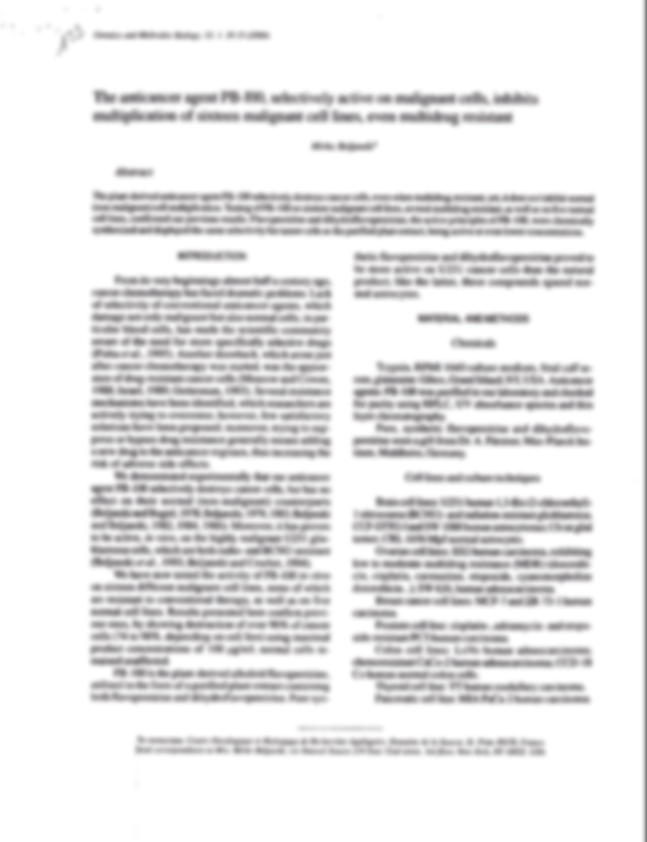53 – Synthèse chez les bactéries d’ARN nouveaux n’étant pas la copie de l’ADN
C.R. Acad. Sci., 1969, 269, pp. 240-243 (série D).
Available in French only
ABSTRACT: Les faits présentés ici montrent que la showdomycine à faible dose fait apparaître chez plusieurs espèces bactériennes des ARN à marquage rapide (ARN-mr) nouveaux, et par son effet mutagène puissant transforme irréversiblement les bactéries d’E. Coli, leur conférant de nouvelles propriétés.
ABSTRACT: Les faits présentés ici montrent que la showdomycine à faible dose fait apparaître chez plusieurs espèces bactériennes des ARN à marquage rapide (ARN-mr) nouveaux, et par son effet mutagène puissant transforme irréversiblement les bactéries d’E. Coli, leur conférant de nouvelles propriétés.
52 – Synthèse dans Escherichia coli des ARN dont la structure primaire diffère totalement de celle de l’ADN
C.R. Acad. Sci., 1968, 267, pp. 1058-1060 (série D).
Available in French only
ABSTRACT: Nos résultats présentés ici montrent clairement que sans modifier la synthèse et la structure primaire de l’ADN on peut induire les cellules Escherichia Coli à synthétiser deux types d’ARN (ARN à marquage rapide et ARN ribosomique 23 S) dont la structure primaire diffère profondément de l’ADN.
ABSTRACT: Nos résultats présentés ici montrent clairement que sans modifier la synthèse et la structure primaire de l’ADN on peut induire les cellules Escherichia Coli à synthétiser deux types d’ARN (ARN à marquage rapide et ARN ribosomique 23 S) dont la structure primaire diffère profondément de l’ADN.
51 – Isolement et caractérisation d’un ARN matriciel d’Alcaligenes faecalis
C.R. Acad. Sci., 1968, 266, pp. 845-847
Available in French only
ABSTRACT: Les résultats présentés ici montrent les caractéristiques d’un ARN matriciel 5,5 S présent dans une fraction d’ARN d’Alcaligenes f. qui contient des ARN dont les coefficients de sédimentation varient de 3,8 à 7,0 S. Nos données permettent d’affirmer que l’ARN matriciel diffère indiscutablement du ARN de transfert et du ARN ribosomal.
ABSTRACT: Les résultats présentés ici montrent les caractéristiques d’un ARN matriciel 5,5 S présent dans une fraction d’ARN d’Alcaligenes f. qui contient des ARN dont les coefficients de sédimentation varient de 3,8 à 7,0 S. Nos données permettent d’affirmer que l’ARN matriciel diffère indiscutablement du ARN de transfert et du ARN ribosomal.
50 – Nouvelle méthode de purification des “polypeptides synthétases”
VII- European J. Biochem., 1968, 4, pp. 118-125.
Available in English only
ABSTRACT: A new method for purification of “polypeptides synthetase” from Alcaligenes faecalis is described in which nucleic acids are removed by purification on DEAE-cellulose with a recovery of 60-75% of the initial enzymatic activity.
ABSTRACT: A new method for purification of “polypeptides synthetase” from Alcaligenes faecalis is described in which nucleic acids are removed by purification on DEAE-cellulose with a recovery of 60-75% of the initial enzymatic activity.
49 – Identification des sites d’attachement spécifiques d’arginine et de valine dans des ARN d’ origines différentes
VIII- European J. Biochem., 1968,4, pp. 184-189.
Article not available online
Article not available online
48 – Nouvelle méthode de purification des polypeptides-synthétases
C.R. Acad. Sci., 1967,264, pp. 411-414 (série D).
Available in French only
ABSTRACT: Une méthode nouvelle de purification des polypeptide-synthétases à partir d’extraits d’Alcaligenes faecalis permet d’obtenir à rendement élevé des préparations enzymatiques substantiellement purifiées.
ABSTRACT: Une méthode nouvelle de purification des polypeptide-synthétases à partir d’extraits d’Alcaligenes faecalis permet d’obtenir à rendement élevé des préparations enzymatiques substantiellement purifiées.
47 – Isolement de di- et trinucléotides, sites spécifiques d’attachement d’arginine et de valine dans des ARN d’ origine différente
C.R. Acad. Sci., 1967,264, pp. 1760-1763 (série D).
Available in French only
ABSTRACT: Un acide aminé donné, attaché par les polypeptide-synthétases à des ARN d’origine différente (Alcaligenes f., E. coli, TYMV) est lié à un même nucléotide spécifique dans les di- et trinucléotides isolés. Les polypeptide-synthétases peuvent directement reconnaître à la fois chaque acide aminé et les sites (triplets) dans l’ARN que nous proposons dorénavant d’appeller ARN matriciel.
ABSTRACT: Un acide aminé donné, attaché par les polypeptide-synthétases à des ARN d’origine différente (Alcaligenes f., E. coli, TYMV) est lié à un même nucléotide spécifique dans les di- et trinucléotides isolés. Les polypeptide-synthétases peuvent directement reconnaître à la fois chaque acide aminé et les sites (triplets) dans l’ARN que nous proposons dorénavant d’appeller ARN matriciel.
46 – Rôle des triterpènes dans l’attachement des l-acides aminés par des “ARN matriciels”
Eur. J. of Clin. Biol. Res., 1971, pp. 897-908
Available in French only
Summary in English
ABSTRACT: Asiaticoside, asiatic and madecassic acids affect the binding of L-14V-proline and L-14C-alanine to m-RNA in the presence of any one of the four nucleoside triphosphates and a partially purified bacterial enzyme preparation whose properties have been previously described. The binding of proline to m-RNA, but not its turnover, is inhibited by any one of the triterpenes used, while that of alanine is highly increased only by free asiatic acid. This latter inhibits the turnover of alanine bound to m-RNA thus shifting the reaction towards an accumulation of the “m-RNA-alanine” complex which is an intermediate in the synthesis of oligopeptides in the present system. The binding of L-amino acids to t-RNA in the presence of ATP is not affected by triterpenes. A hypotesis is proposed to account for the effect of triterpenes in mammalian cells in connection with biosynthesis of collagen, a protein rich in proline, hydroxyproline and alanine.
ABSTRACT: Asiaticoside, asiatic and madecassic acids affect the binding of L-14V-proline and L-14C-alanine to m-RNA in the presence of any one of the four nucleoside triphosphates and a partially purified bacterial enzyme preparation whose properties have been previously described. The binding of proline to m-RNA, but not its turnover, is inhibited by any one of the triterpenes used, while that of alanine is highly increased only by free asiatic acid. This latter inhibits the turnover of alanine bound to m-RNA thus shifting the reaction towards an accumulation of the “m-RNA-alanine” complex which is an intermediate in the synthesis of oligopeptides in the present system. The binding of L-amino acids to t-RNA in the presence of ATP is not affected by triterpenes. A hypotesis is proposed to account for the effect of triterpenes in mammalian cells in connection with biosynthesis of collagen, a protein rich in proline, hydroxyproline and alanine.
45 – L’ARN isolé du virus de la mosaïque jaune du Navet, accepteur des L-acides aminés en présence d’enzymes bactériennes
Bull. Soc. Chim. Biol. 1965, 47, pp. 1645-1652.
Available in French only
ABSTRACT: Résultats concernant la formation du complexe entre les acides L-acides aminés 14C et l’ARN purifié, isolé du virus de la mosaïque jaune du Navet.
ABSTRACT: Résultats concernant la formation du complexe entre les acides L-acides aminés 14C et l’ARN purifié, isolé du virus de la mosaïque jaune du Navet.
44 – Messenger RNA Dependent Synthesis of Peptides by Purified Bacterial Enzymes
Bioch-Zeits, 1965, 342, pp. 392-399.
Article in English, not available online
Article in English, not available online




